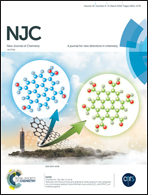FeOOH nanorod arrays aligned on eggplant derived super long carbon tube networks as negative electrodes for supercapacitors†
Abstract
A beautiful and unique super long carbon tube network structure was synthesized via a freeze-drying technique and then carbonization of natural eggplant in a nitrogen atmosphere. Subsequently, nanorod-like FeOOH arrays were evenly grown on the surface of the carbon material via an easy and efficient hydrothermal process without any toxic chemicals. The composites grown for 5 h exhibited excellent performance, including a specific capacitance of 396 F g−1 within a potential window of −1.08 to 0 V at a current density of 0.5 A g−1 (2 times that of the pure eggplant derived carbon) and a good cycling stability (83% over 500 cycles at a current density of 10 A g−1). It is speculated that the synergistic effect of the super long hollow carbon tube network and the nanorod-like FeOOH arrays contributes to the fast electron transport and the battery-type capacitance behavior, respectively, thus enhancing the electrochemical performance. The above results indicate that the prepared nanocomposites are a potential negative electrode for supercapacitors.



 Please wait while we load your content...
Please wait while we load your content...